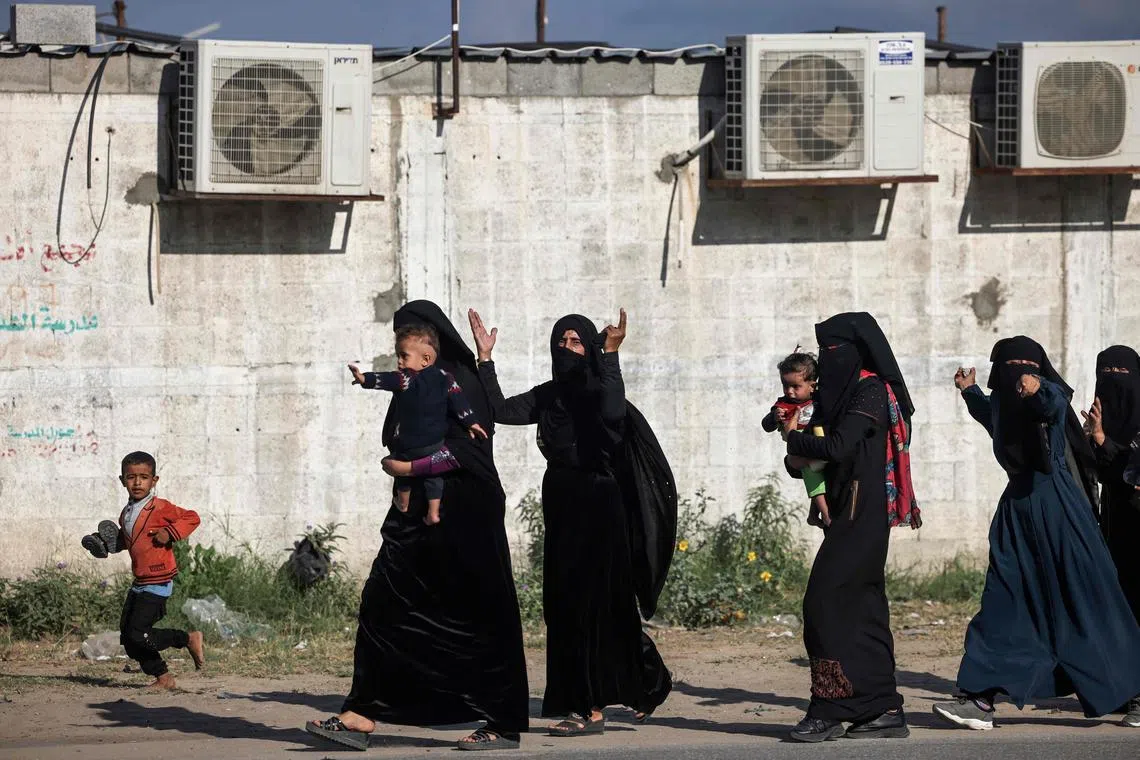Why Gaza is epicentre of Israeli-Palestinian conflict
Sign up now: Get ST's newsletters delivered to your inbox

Residents in the Gaza Strip fleeing their homes to move away from the border with Israel, on Oct 7.
PHOTO: AFP
Follow topic:
Since the militant Islamist group Hamas took control of Gaza in 2007, the small, overcrowded enclave has been the focal point in Israel’s military conflict with the Palestinians.
Thousands of Gazans have died in Israeli air strikes provoked mostly by rocket attacks launched by Hamas fighters or, in the most recent case, other militants.
Frequent power cuts, grinding poverty and the constant fear of more bombardment have left many Gazans dreaming of escape.
That is rarely an option. With movement in and out of the territory severely restricted, it has been described by some rights activists as an open-air prison.
1. What is Gaza?
Also known as the Gaza Strip, it is a territory about 40km long and 12km wide bounded by Israel, Egypt and the Mediterranean Sea. Once a part of the Ottoman and later the British empire, it became a refuge for an estimated 200,000 Palestinians uprooted by the Arab-Israeli war of 1948.
Egypt ruled Gaza until it lost it to Israel in the 1967 Six-Day War. In 2005, Israel withdrew troops from Gaza and abandoned settlements of Israeli citizens.
Today, Gaza is one of two territories, along with the West Bank, where Palestinians exercise limited self-government. Israel maintains control of Gaza’s airspace and maritime territory and also enforces a blockade, along with Egypt.
2. Who governs the territory?
For about a decade, until 2006, Gaza was governed by the Palestinian Authority, the body that also administers the West Bank and is dominated by Al-Fatah, the main faction of the Palestine Liberation Organisation, which signed a peace deal with Israel.
That year, Hamas, which rejects Israel, won legislative elections. After months of fighting, Hamas took control of Gaza. Israel responded by imposing a blockade, saying it needed to protect its people.
Since then, Israel and Hamas militants in Gaza have fought four significant military confrontations. While Hamas controls security in Gaza, funding for health, power and other services comes mostly from the United Nations and foreign countries, either directly or through the Palestinian Authority.
3. What is it like to live there?
The UN estimates that more than 5,200 Gazans have been killed in the sporadic conflicts with Israel. Many of them are children and most died as a result of Israeli air strikes.
A report in 2021 from the advocacy group Euro-Med Monitor stated that nine out of 10 children in Gaza were suffering some form of conflict-related trauma.
Most Gazans live in refugee camps that were set up more than seven decades ago to house Palestinians displaced in the 1948 war.
With economic activity limited, many of them still rely on UN rations.
Israel’s 15-year blockade has also deepened the poverty. Power outages occur daily for several hours. Most tap water is undrinkable, forcing households to buy desalinated water from private vendors.
Open criticism of Hamas is dangerous, but many Gazans complain in private.
4. Why things do not improve?
An isolated territory devoid of natural resources with a long history of poverty and a refugee majority faces enormous challenges under any circumstances.
Add to that, both Israel and Egypt look upon Gaza with fear and suspicion as long as it is run by Hamas. They maintain a blockade and destroy tunnels used to smuggle goods in.
Israel has taken limited steps in recent years to ease Gaza’s plight, including issuing permits for 20,000 Gazans to work in Israel, where they earn 10 times what they would at home.
But there is little immediate hope for the kind of peace deal that would significantly improve living conditions. The situation is complicated by the presence in Gaza of a smaller and even more militant group, independent of Hamas, that was responsible for the most recent attacks on Israel.
5. What caused the latest violence?
The group, Islamic Jihad, launched around 100 rockets at Israel after one of its members died of a hunger strike in an Israeli prison. Most were intercepted by Israel’s Iron Dome missile defence system, preventing any fatalities.
Israel responded by assassinating four top Islamic Jihad commanders and some 20 civilians.
Like Hamas, Islamic Jihad receives support from Iran. It is even less willing to compromise with Israel and has proven willing to act alone against their common enemy. BLOOMBERG

